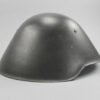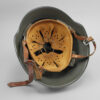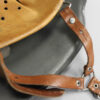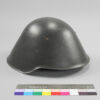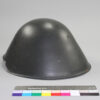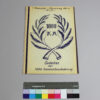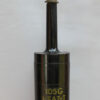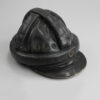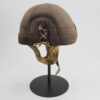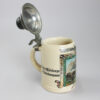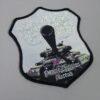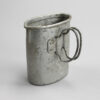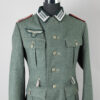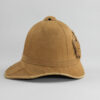NVA steel helmet model 1956
Inventory number: DPM 1.919
The task of a helmet is clear – to protect the head. But even if the requirements have not changed in the decades between the two world wars, countless designs have been tried out internationally. In many respects, the steel helmet design introduced with the formation of the National People’s Army of the GDR in 1956 represents the most effective protection that could be achieved with the material steel – surpassed only by the new Kevlar helmets. From a purely technical point of view, this helmet shape offers many advantages: With its high fit on the head and widely protruding brim, it gives the helmet wearer great freedom of movement and restricts the field of vision and hearing much less than its Wehrmacht predecessor. The smooth shape and the exaggerated angle of the helmet bell were the result of firing tests; the steep angle of impact deflects splinters and, under favorable circumstances, even bullets. However, its shape also had disadvantages: the helmet sat less securely on the head and the protruding shape of the helmet could also get in the way, for example when dismounting from vehicles. After extensive testing, the NVA troops received the first 50,000 steel helmets in the fall of 1957.
However, a helmet must not only protect, but also always represents a part of the identity of the armed forces and must position itself in relation to historical designs. While the design of the US armed forces served as inspiration in the Federal Republic of Germany and US steel helmets were tested, the armed forces of the GDR initially wore uniforms that were very similar to those of the Soviet army. The Kasernierte Volkspolizei (KVP), the predecessor of the NVA, also used Soviet steel helmets for their field exercises. As early as 1953, however, VEB Schwerter Emaillefabrik supplied its own sample helmets for testing, none of which were introduced into the KVP.
The search for a suitable helmet was urgent and so the choice fell on a Wehrmacht helmet that had already been tested but was no longer in use. From 1943, this was intended as a further development of the M 35 model, whose creases were a bullet trap. The resulting smooth design bore little visual resemblance to the iconic German steel helmet design. With the establishment of the NVA in 1956, the brown Soviet-style uniforms gave way to a new uniform to emphasize the German national identity.
This new identity of the armed forces of the GDR was based on its dissociation from Prussian militarism and the NVA was to be completely integrated into the socialist ideology in terms of its structure and personnel. The political leadership of the GDR saw the tradition of the NVA as a “people’s army” from the Peasants’ War of 1524/25 to the communist resistance against fascism. It expected both patriotism and solidarity with socialist internationalism from its command personnel. The officer corps was not supposed to be an elite, but to see itself as part of society and the working class. Only a few years after the dissolution of the Wehrmacht, the SED succeeded in creating a new military leadership class which, in comparison to the Bundeswehr, only had a few former Wehrmacht officers to fall back on. However, the “Workers’ and Peasants’ Army” could not do without them entirely, even if this part of the NVA’s history remained unthematized in the GDR. As much as the Socialist People’s Army set itself apart from the personnel and spirit of the previous German armies, it adopted their uniform elements and traditions with little awareness of the problem and, with the steel helmet, even adopted the planned Wehrmacht model M 45 with only a few changes.
Object of the month
(short) stories from the depot
Unfortunately, many objects cannot currently be shown in the exhibition for conservation reasons. Here you will find unusual objects and exciting stories of special pieces from the depot


